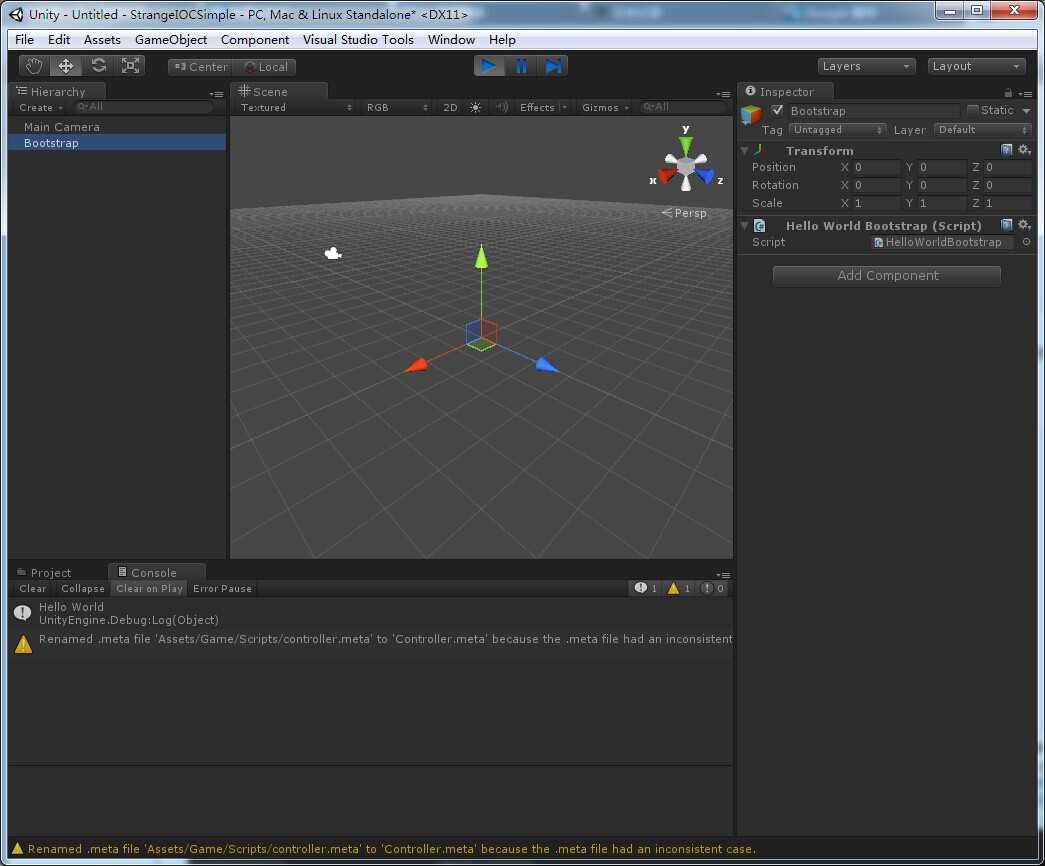标签:style blog http io ar color os 使用 sp
好久没有发blog了,因为只发原创内容,而去年发布的那几篇后来发现随便百度到处都是转载的或者各种网站自动扒的,我觉得既然大家都不尊重这种东西就没必要发上来了!不过由于工作原因最近在看Unity的一个IOC框架:StrangeIOC,官方的文档都不是很好理解,找到了一篇比较好的GetStart文章,顺手翻译一下,一来方便自己加深理解,二来还是想共享出来,没事,随意转吧,拜托注明下出处!原文在这里(不太清楚有没有被墙)
译文:
Strange是一个Unity3D中用于控制反转的第三方框架,控制反转(IOC-Inversion of Control)思想是类间解耦的一个重要方法,对于我来说,任何解耦技术都值得去学习。什么是IOC?这里有详细解答。IOC框架已经在企业级开发和其他非游戏软件的开发中成为了主流,并且可以说已经非常成熟。我觉得它可以帮助游戏开发变得更加容易测试,更好的进行协作开发。我非常想尝试它看看到底可以在游戏开发过程中起到多大的帮助程度。
Assets
StrangeIoC
scripts
在Assets文件夹下创建"Game"文件夹,即用来创建Hello World示例的文件夹。文件夹的的结构应该是这样的:
Assets
Game
Scenes
Scripts
在Scripts文件夹下新建名为HelloWorldSignals.cs的c#脚本,这个类将包含所有用到的signal,让我们coding起来:
using System; using strange.extensions.signal.impl; namespace Game { public class StartSignal : Signal {} }
在Strange中,这个signal的概念非常像观察者模式(observer pattern)中的事件(events)。在这里,它以命名类的方式实现了继承Strange的Signal类.别急,我们马上会看到怎么去使用它。
using System; using UnityEngine; using strange.extensions.context.impl; using strange.extensions.command.api; using strange.extensions.command.impl; using strange.extensions.signal.impl; namespace Game { public class SignalContext : MVCSContext { /** * Constructor */ public SignalContext (MonoBehaviour contextView) : base(contextView) { } protected override void addCoreComponents() { base.addCoreComponents(); // bind signal command binder injectionBinder.Unbind<ICommandBinder>(); injectionBinder.Bind<ICommandBinder>().To<SignalCommandBinder>().ToSingleton(); } public override void Launch() { base.Launch(); Signal startSignal = injectionBinder.GetInstance<StartSignal>(); startSignal.Dispatch(); } } }
在"Scripts"文件夹下创建一个新文件夹"Controller",到这里有了一点MVC模式的特征。Strange作者建议我们应该以指令类(Command Class)的形式实现各个Controller接口,这个文件夹将包含所有的Command类,现在我们创建一个在StartSignal指令调用时执行的指令。在Controller文件夹下创建名为HelloWorldStartCommand.cs的类:
using System; using UnityEngine; using strange.extensions.context.api; using strange.extensions.command.impl; namespace Game { public class HelloWorldStartCommand : Command { public override void Execute() { // perform all game start setup here Debug.Log("Hello World"); } } }
using System; using UnityEngine; using strange.extensions.context.impl; namespace Game { public class HelloWorldContext : SignalContext { /** * Constructor */ public HelloWorldContext(MonoBehaviour contextView) : base(contextView) { } protected override void mapBindings() { base.mapBindings(); // we bind a command to StartSignal since it is invoked by SignalContext (the parent class) on Launch() commandBinder.Bind<StartSignal>().To<HelloWorldStartCommand>().Once(); } } }
在这里,我们把StartSignal类绑定(bind)给了HelloWorldStartCommand类。这样在StartSignal的实例被调用时,HelloWorldStartCommand会进行实例化(instantiated)和执行(executed),注意在我们的示例中StartSignal信号会在SignalContext.Launch()方法中调用发出。
using System; using UnityEngine; using strange.extensions.context.impl; namespace Game { public class HelloWorldBootstrap : ContextView { void Awake() { this.context = new HelloWorldContext(this); } } }

namespace Game { public interface ISomeManager { /** * Perform some management */ void DoManagement(); } }
这就是我们示例当中的manager接口,注意:Strange的作者建议我们总是使用一个接口然后通过injectionBinder将它映射到一个真正的实现类,当然,你也可以使用多对多的映射。接下来我们创建一个具体实现类,在Scripts文件夹下创建ManagerAsNormalClass.cs脚本:
using System; using UnityEngine; namespace Game { public class ManagerAsNormalClass : ISomeManager { public ManagerAsNormalClass() { } #region ISomeManager implementation public void DoManagement() { Debug.Log("Manager implemented as a normal class"); } #endregion } }
如果你仔细在看你可能会发现这是一个没有MonoBehaviour的manager,别急,一会再介绍怎么bind有MonoBehaviour的
现在我们来创建一个简单的交互场景,效果是当一个Button按下时,ISomeManager的DoManagement函数执行,这里我们有一个要求:用MVC思想---对controll层(ISomeManager)和view层(控制Button触发事件的脚本)完全解耦,view层只需要通知controll层:"hey!button被点击了",至于接下来发生什么交由controll层进行逻辑处理。
现在缺一个view层,把它创建出来吧---在Game文件夹下创建"View"文件夹,创建HelloWorldView.cs脚本:
using System; using UnityEngine; using strange.extensions.mediation.impl; using strange.extensions.signal.impl; namespace Game { public class HelloWorldView : View { public Signal buttonClicked = new Signal(); private Rect buttonRect = new Rect(0, 0, 200, 50); public void OnGUI() { if(GUI.Button(buttonRect, "Manage")) { buttonClicked.Dispatch(); } } } }
这里继承的Strange框架中的View类已经包含了MonoBehaviour。所有使用Strange context的View层类都必须继承这个Strange的View类,我们刚刚创建的View类只有一个交互功能:在点击名为"Manage"的Button后,调用一个 generic signal(通用信号) 。
Strange作者建议对每个View创建对应的Mediator。Mediator是一个薄层,他的作用是让与之对应的View和整个程序进行交互。mediation binder的作用是把View映射到它对应的mediator上。所以接下来为View层创建对应的mediator---在"view"文件夹下创建HelloWorldMediator.cs脚本:
using System; using UnityEngine; using strange.extensions.mediation.impl; namespace Game { public class HelloWorldMediator : Mediator { [Inject] public HelloWorldView view {get; set;} [Inject] public ISomeManager manager {get; set;} public override void OnRegister() { view.buttonClicked.AddListener(delegate() { manager.DoManagement(); }); } } }
在这段代码里我们可以看到神奇的"Inject"标注(Inject attribute)。这个"Inject"标注只能和变量搭配使用,当一个变量上面有"Inject"标注时,意味着Strange会把这个变量的一个实例自动注入到它对应映射的context中。据此从我们上面的代码来分析,在这里我们获取到了"view"和"manager"的实例,并且不用去关心这些个实例是怎么来的。
OnRegister()是一个可以被重写的方法,它用来标记实例注入完成已经可以使用了,它的意义主要是进行初始化,或者说做准备。在上面的类中,OnRegister方法中为HellowWorldView.buttonClicked signal添加了一个监听器,这个监听器的逻辑是按下就执行manager.DoManagement方法。
protected override void mapBindings() { base.mapBindings(); // we bind a command to StartSignal since it is invoked by SignalContext (the parent class) during on Launch() commandBinder.Bind<StartSignal>().To<HelloWorldStartCommand>().Once(); // bind our view to its mediator mediationBinder.Bind<HelloWorldView>().To<HelloWorldMediator>(); // bind our interface to a concrete implementation injectionBinder.Bind<ISomeManager>().To<ManagerAsNormalClass>().ToSingleton(); }


using System; using UnityEngine; namespace Game { public class ManagerAsMonoBehaviour : MonoBehaviour, ISomeManager { #region ISomeManager implementation public void DoManagement() { Debug.Log("Manager implemented as MonoBehaviour"); } #endregion } }
protected override void mapBindings() { base.mapBindings(); // we bind a command to StartSignal since it is invoked by SignalContext (the parent class) during on Launch() commandBinder.Bind<StartSignal>().To<HelloWorldStartCommand>().Once(); // bind our view to its mediator mediationBinder.Bind<HelloWorldView>().To<HelloWorldMediator>(); // REMOVED!!! //injectionBinder.Bind<ISomeManager>().To<ManagerAsNormalClass>().ToSingleton(); // bind the manager implemented as a MonoBehaviour ManagerAsMonoBehaviour manager = GameObject.Find("Manager").GetComponent<ManagerAsMonoBehaviour>(); injectionBinder.Bind<ISomeManager>().ToValue(manager); }

using System; using strange.extensions.signal.impl; namespace Game { public class StartSignal : Signal {} public class DoManagementSignal : Signal {} // A new signal! }
using System; using UnityEngine; using strange.extensions.context.api; using strange.extensions.command.impl; namespace Game { public class DoManagementCommand : Command { [Inject] public ISomeManager manager {get; set;} public override void Execute() { manager.DoManagement(); } } }
using System; using UnityEngine; using strange.extensions.mediation.impl; namespace Game { public class HelloWorldMediator : Mediator { [Inject] public HelloWorldView view {get; set;} [Inject] public DoManagementSignal doManagement {get; set;} public override void OnRegister() { view.buttonClicked.AddListener(doManagement.Dispatch); } } }
protected override void mapBindings() { base.mapBindings(); // we bind a command to StartSignal since it is invoked by SignalContext (the parent class) during on Launch() commandBinder.Bind<StartSignal>().To<HelloWorldStartCommand>().Once(); commandBinder.Bind<DoManagementSignal>().To<DoManagementCommand>().Pooled(); // THIS IS THE NEW MAPPING!!! // bind our view to its mediator mediationBinder.Bind<HelloWorldView>().To<HelloWorldMediator>(); // bind the manager implemented as a MonoBehaviour ManagerAsMonoBehaviour manager = GameObject.Find("Manager").GetComponent<ManagerAsMonoBehaviour>(); injectionBinder.Bind<ISomeManager>().ToValue(manager); }
Get Start StrangeIOC for Unity3D
标签:style blog http io ar color os 使用 sp
原文地址:http://www.cnblogs.com/funyuto/p/4143790.html